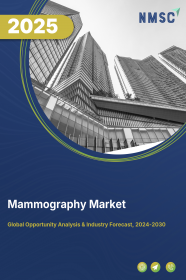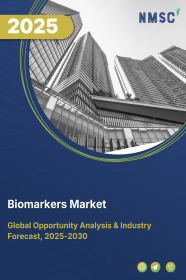
Mammography Market by Type (Screening Mammogram and Diagnostic Mammogram), by Product Type (Film Screen Systems, Digital Systems, Analog Systems, Biopsy Systems, 3D Systems, and Others), by Modality (Portable Mammography Systems, Non-Portable Mammography Systems), by Technology (Breast Tomosynthesis, Computer Aided Detection (CAD), Analog Mammography, Digital Mammography, and Others) and by End User - Global Opportunity Analysis and Industry Forecast 2023-2030
US Tariff Impact on Mammography Market
Trump Tariffs Are Reshaping Global Business
Market Definition
The global Mammography Market size was valued at USD 2.26 billion in 2022 and is predicted to reach USD 4.48 billion by 2030 with a CAGR of 8.9% from 2023-2030. Mammography is a method to detect and examine changes in breast tissues. It is a non-invasive medical imaging and diagnostic procedure that uses x-rays to monitor the presence of tumors in breast tissue.
In this method, the breast is pushed between two hard surfaces to disperse the tissues of the breast. X-rays are then displayed on the computer screen to capture a black-and-white image that is inspected for signs of cancer. Mammography is widely used to examine the breast for the early detection of cancer and other breast diseases such as benign, fibrocystic and hyperplasia. This method is one of the most commonly used techniques for checking asymptomatic anomalies and allows women to be aware of the health of their breasts.
Market Dynamics and Trends
The rising incidence of breast cancer across the globe is a major factor that is driving the mammography market. According to the World Health Organization (WHO), approximately 2.3 million women diagnosed with breast cancer and 685 000 deaths in 2020 globally. Also, the growing government initiatives and investments to develop women's healthcare and early detection of breast cancer is further propelling the growth of the market. For instance, in May 2021, Australian government announced an investment of almost USD 354 million in their federal budget for women’s health to increase screening of breast cancers and cervical cancers.
Moreover, increasing efforts by various NGOs and international organizations to raise awareness about early detection of macrocalcification of breast tissue that causes breast cancer leads to the market expansion of mammography market. various organizations such as the National Breast Cancer Foundation, Centers for Disease Control & Prevention and Breast Cancer Organization that are promoting early detection of breast calcification globally have resulted into greater utilization of mammography that is expected to drive the growth of market during the forecast period. For instance, the National Breast Cancer Foundation provides early detection screenings, including mammograms, breast health education, and a supportive community. They offer help and inspire hope to those affected by breast cancer through early detection, education, and support services.
However, societal stigma due to lack of education and low socio-economic status that contributes to avoid breast cancer screening and health concerns related to radiation exposure risks are the factors restraining the growth of market during the forecast period. On the contrary, growing adoption and utilization of advanced digital technology in mammography devices such as 3D digital mammography that generates high-quality images from various angles is significantly fueling the market growth. This results in accurate and early detection of breast cancer cells which is expected to create ample growth opportunities for the market in the coming years.
Market Segmentations and Scope of the Study
The mammography market report is segmented on the basis of type, product type, modality, technology, end user and geography. On the basis of type, the market is divided into screening mammogram and diagnostic mammogram. On the basis of product type, the market is classified into film screen systems, digital systems, analog systems, biopsy systems, 3d systems and others. On the basis of modality, the market is categorized into portable mammography systems, non-portable mammography systems.
On the basis of technology, the market is categorized into breast tomosynthesis, computer aided detection (CAD), analog mammography, digital mammography and others. On the basis of end user, the market is bifurcated into ambulatory surgical centers, impatient settings, hospitals, diagnostic centers, specialty clinics, research institutes and others. Geographic breakdown and analysis of each of the aforesaid segments includes regions comprising of North America, Europe, Asia-Pacific, and RoW.
Geographical Analysis
North America holds the dominant share of mammography market and is expected to continue its dominance during the forecast period. This is attributed to increasing cases of breast cancer cases, along with rising awareness about breast cancer among individuals in this region. According to World Health Organization (WHO), Mexico reported 29,929 new breast cancer cases, while Canada reported 274,364 new cases of breast cancer in 2020.
Also, the presence of major key players such as Hologic Inc., GE Healthcare, Gamma Medica and Analogic Corporation that are adopting various strategic such as partnerships and expansions in turn boost the market growth in the region. For instance, in April 2022, GE Healthcare partnered with DetectedX to expand access to promote global diagnostic accuracy excellence. This online learning platform is designed to improve the ability of radiologists to correctly detect breast lesions in 2D and 3D mammography while improving cancer detection by more than 34%.
On the other hand, Asia-Pacific is expected to show a steady rise in the mammography market due to the expanding healthcare infrastructure and improved access to medical facilities in countries such as India, China, and Southeast Asian nations. For instance, China's healthcare spending significantly grown over the last two decades across all sources, with total expenditure reaching approximately USD 1.2 trillion in 2021, more than doubling from 2015 and healthcare expenditure accounted for 6.5% of the annual GDP in 2021.
Moreover, rising government initiatives aimed at improving breast cancer detection and care in various countries such as China, India and Japan are expected to drive the mammography market growth in this region. For instance, in October 2021, in India, Goa government announced an initiative for free breast cancer screening for 1 lakh women over a period of two years. It was funded by the Indian Institute of Banking & Finance and SBI Foundation. Under this initiative, free breast cancer screening by using ‘iBreast’ devices and free treatment were provided for all positive cases.
Competitive Landscape
The mammography industry trends comprising of various market players such as Hologic Inc., Konica Minolta Inc., GE Healthcare, Siemens Healthcare, Toshiba Corporation, Fujifilm Holding Corporation, Planmeca OY, Canon Medical Systems Corporation, Metaltronica and Gamma Medica. These market players are adopting various strategies such as product approvals and product launches to maintain their dominance in the global market.
For instance, in July 2023, Konica Minolta launched handheld ultrasound device with portable and convenient imaging capabilities, potentially influencing the accessibility and efficiency of diagnostic procedures in various medical fields, including mammography. This expansion showcases Konica Minolta's diversification in medical imaging solutions.
Moreover, in August 2021, Fujifilm partnered with ScreenPoint Medical to leverage ScreenPoint's advanced AI-based breast imaging solutions. The partnership with ScreenPoint reinforces Fujifilm's commitment to enhancing mammography technology, showcasing their dedication to providing innovative tools that improve breast cancer detection and diagnosis, and expanding their footprint in the evolving mammography market.
Key Benefits
-
The report provides quantitative analysis and estimations of the mammography market from 2023 to 2030, which assists in identifying the prevailing market opportunities.
-
The study comprises a deep-dive analysis of the mammography market including the current and future trends to depict prevalent investment pockets in the market.
-
Information related to key drivers, restraints, and opportunities and their impact on the global market is provided in the report.
-
Competitive analysis of the players, along with their market share is provided in the report.
-
SWOT analysis and Porters Five Forces model is elaborated in the study.
-
Value chain analysis in the market study provides a clear picture of roles of stakeholders.
Mammography Market Key Segments
By Type
-
Screening Mammogram
-
Diagnostic Mammogram
By Product Type
-
Film Screen Systems
-
Digital Systems
-
Analog Systems
-
Biopsy Systems
-
3D Systems
-
Others
By Modality
-
Portable Mammography Systems
-
Non-Portable Mammography Systems
By Technology
-
Breast Tomosynthesis
-
Computer Aided Detection (CAD)
-
Analog Mammography
-
Digital Mammography
-
Others
By End User
-
Ambulatory Surgical Centers
-
Impatient Settings
-
Hospitals
-
Diagnostic Centers
-
Specialty Clinics
-
Research Institutes
-
Others
By Region
-
North America
-
US
-
Canada
-
Mexico
-
-
Europe
-
UK
-
Germany
-
France
-
Spain
-
Italy
-
Netherlands
-
Denmark
-
Finland
-
Norway
-
Sweden
-
Russia
-
Rest of Europe
-
-
Asia-Pacific
-
China
-
Japan
-
India
-
Australia
-
South Korea
-
Thailand
-
Singapore
-
Rest of Asia-Pacific
-
-
RoW
-
Latin America
-
Middle East
-
Africa
-
Key Players
-
Hologic Inc.
-
Konica Minolta Inc.
-
GE Healthcare
-
Siemens Healthcare
-
Toshiba Corporation
-
Fujifilm Holding Corporation
-
Planmeca OY
-
Canon Medical Systems Corporation
-
Metaltronica
-
Gamma Medica
Report Scope and Segmentation
|
Parameters |
Details |
|
Market Size in 2022 |
USD 2.26 Billion |
|
Revenue Forecast in 2030 |
USD 4.48 Billion |
|
Growth Rate |
CAGR of 8.9% from 2023 to 2030 |
|
Analysis Period |
2022–2030 |
|
Base Year Considered |
2022 |
|
Forecast Period |
2023–2030 |
|
Market Size Estimation |
Billion (USD) |
|
Growth Factors |
Rising incidence of breast cancer across the globe. Growing initiatives by International Organization |
|
Countries Covered |
28 |
|
Companies Profiled |
10 |
|
Market Share |
Available for 10 companies |
|
Customization Scope |
Free customization (equivalent up to 80 working hours of analysts) after purchase. Addition or alteration to country, regional, and segment scope. |
|
Pricing and Purchase Options |
Avail customized purchase options to meet your exact research needs. |

















 Speak to Our Analyst
Speak to Our Analyst




















